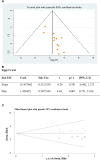Immediate postpartum family planning utilization and its associated factors among postpartum women in Ethiopia: a systematic review and meta-analysis
- PMID: 37674902
- PMCID: PMC10478094
- DOI: 10.3389/fgwh.2023.1095804
Immediate postpartum family planning utilization and its associated factors among postpartum women in Ethiopia: a systematic review and meta-analysis
Abstract
Background: Family planning integration in areas where women contact the healthcare system routinely is essential for addressing the high unmet need for family planning among postpartum women and reducing the risk of short interpregnancies. Immediate postpartum family planning (IPPFP) is an integrated service, and opportunities exist for women by providing family planning (FP) counseling and contraceptives as part of care following childbirth within 48 h. Therefore, this review aimed to assess the pooled estimate of immediate postpartum family planning utilization and its associated factors in Ethiopia.
Method: Electronic databases were used to conduct an extensive search of all published studies, and the digital library was used to identify any unpublished studies. An observational study that reports the prevalence/magnitude and/or associated factors/predictors/determinants of IPPFP utilization in Ethiopia was included. Data were extracted on the Microsoft Excel spreadsheet and analyzed using STATA Version 11. A random-effects model was applied to determine the pooled prevalence of immediate postpartum family planning utilization with a 95% confidence interval (CI). Inverse variance (I2) was used to identify the presence of heterogeneity, and a funnel plot and Egger's test were used to check the presence of publication bias. Subgroup analysis was conducted based on the sample size, region, and year of study to identify the source of heterogeneity.
Result: Of 15 primary studies, the overall pooled prevalence of immediate postpartum family planning utilization among postpartum women in Ethiopia was 21.04% (95% CI: 13.08, 29.00). Received counseling on FP [OR: 3.59; 95% CI (1.84, 7.01; P < 0.001), having a positive attitude toward FP [OR: 3.2; 95% CI (1.23, 8.35); P = 0.017], and partner support to use FP [OR: 5.85; 95% CI (1.12, 30.54; P = 0.036) were significant predictors of immediate postpartum family planning utilization.
Conclusion: Generally, IPPFP utilization in Ethiopia was insufficient. Therefore, to enhance the utilization, integrating FP counseling at all maternal service care points, strengthening community awareness to develop a favorable attitude toward family planning, and promoting partner involvement in family planning counseling are essential.
Systematic review registration: https://www.crd.york.ac.uk/PROSPERO/display_record.php?RecordID=239053, identifier: CRD42021239053.
Keywords: Ethiopia; family planning; immediate postpartum; postpartum; utilization.
© 2023 Silesh, Demisse, Taye, Moltot, Chekole, Wogie, Kasahun and Adanew.
Conflict of interest statement
The authors declare that the research was conducted in the absence of any commercial or financial relationships that could be construed as a potential conflict of interest.
Figures






Similar articles
-
Immediate postpartum modern family planning utilization and associated factors among postpartum women in Gurage Zone, Southern Ethiopia 2022: community-based cross-sectional study.Front Glob Womens Health. 2025 Apr 4;6:1355620. doi: 10.3389/fgwh.2025.1355620. eCollection 2025. Front Glob Womens Health. 2025. PMID: 40256154 Free PMC article.
-
Magnitude and associated factors of postpartum family planning uptake among postpartum women in Ethiopia: an umbrella review.Front Glob Womens Health. 2024 Dec 18;5:1481601. doi: 10.3389/fgwh.2024.1481601. eCollection 2024. Front Glob Womens Health. 2024. PMID: 39759834 Free PMC article.
-
Postpartum modern contraception utilization and its determinants in Ethiopia: A systematic review and meta-analysis.PLoS One. 2020 Dec 14;15(12):e0243776. doi: 10.1371/journal.pone.0243776. eCollection 2020. PLoS One. 2020. PMID: 33315904 Free PMC article.
-
Discontinuation of long acting reversible contraceptive use and its determinants among women in Ethiopia: Systematic review and meta-analysis.Front Public Health. 2022 Dec 6;10:979231. doi: 10.3389/fpubh.2022.979231. eCollection 2022. Front Public Health. 2022. PMID: 36561863 Free PMC article.
-
The Level of Unmet Need for Family Planning and Its Predictors among HIV-Positive Women in Ethiopia: A Systematic Review and Meta-Analysis.Biomed Res Int. 2021 Jan 21;2021:3139272. doi: 10.1155/2021/3139272. eCollection 2021. Biomed Res Int. 2021. PMID: 33553422 Free PMC article.
Cited by
-
Family planning utilization among postpartum women in the Bule Hora District, southern Ethiopia.Front Glob Womens Health. 2024 Dec 9;5:1323024. doi: 10.3389/fgwh.2024.1323024. eCollection 2024. Front Glob Womens Health. 2024. PMID: 39717797 Free PMC article.
-
Level of immediate postpartum family planning utilization and the associated factors among postpartum mothers, Bole Sub-city, Addis Ababa, Ethiopia: institution based cross-sectional study.BMC Womens Health. 2024 Apr 13;24(1):237. doi: 10.1186/s12905-024-03038-7. BMC Womens Health. 2024. PMID: 38615004 Free PMC article.
-
Immediate postpartum modern family planning utilization and associated factors among postpartum women in Gurage Zone, Southern Ethiopia 2022: community-based cross-sectional study.Front Glob Womens Health. 2025 Apr 4;6:1355620. doi: 10.3389/fgwh.2025.1355620. eCollection 2025. Front Glob Womens Health. 2025. PMID: 40256154 Free PMC article.
-
Magnitude and associated factors of postpartum family planning uptake among postpartum women in Ethiopia: an umbrella review.Front Glob Womens Health. 2024 Dec 18;5:1481601. doi: 10.3389/fgwh.2024.1481601. eCollection 2024. Front Glob Womens Health. 2024. PMID: 39759834 Free PMC article.
References
-
- United Nations Department of Economic and Social Affairs, Division SAP. Family Planning and the 2030 Agenda for Sustainable Development (2019). Available at: https://www.un.org/en/development/desa/population/publications/pdf/famil....
-
- WHO. WHO Programming Strategies for Postpartum Family Planning (2013). Geneva. Available at: http://www.who.int/reproduc¬tivehealth/publications/family_planning/ppfp....
-
- High Impact Practices in Family Planning (HIPs). Family planning high impact practices list. Washington, DC: The High Impact Practices Partnership; (2022). Available at: https://www.fphighimpactpractices.org/briefs/family-planning-high-impact...
Publication types
LinkOut - more resources
Full Text Sources

